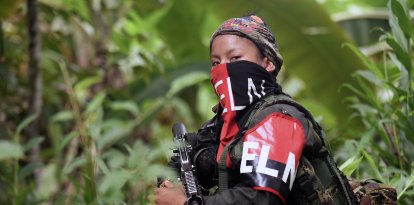Nagorno-Karabakh: Azeri invasion forces new exodus of Armenians
At least 125 civilians fleeing to Armenia died in a gas station explosion. Yerevan authorities report another 200 deaths in armed clashes with Azerbaijan.

(Cordon Press)
The offensive by Azerbaijani forces on the self-proclaimed Republic of Artsakh ended the breakaway state’s independent rule in the region. There is now a mass exodus of ethnic Armenian civilians fleeing reprisals and violence.
According to international observers, tens of thousands of Artsakhs are fleeing the region in a caravan of cars crossing the mountainous enclave. According to data from the Armenian government, there are already more than 50,000 ethnically la Armenian civilians from the Republic of Artsakh who have fled since the beginning of this new exodus. They are fleeing then now collapsed Artsakh state, which had been internationally recognized as Azerbaijan throughout the conflict.
Azerbaijan military victory
The exodus began shortly after Artsakh's armed forces surrendered to the Azerbaijani offensive. Hostilities between the two factions resumed in 2020 after more than 20 years of tensions and small clashes. The Azeri armed forces, supported by Turkey, who possessed superior technology, then launched a series of offensives against Artsakh positions in Nagorno-Karabakh.
Thanks to the intensive use of Turkish Bayraktar drones, among other resources, Azerbaijani forces advanced their positions in the Artsakh enclave. The Russian military intervention stopped the advance of the Baku troops and achieved a ceasefire. Russia maintains its peace mission in Nagorno-Karabakh to this day.
On Sept. 19, Azerbaijan launched a new offensive that ended with the surrender of the independent government of the Republic of Artsakh and its armed forces. The Azeri armed forces then began to occupy positions in Nagorno-Karabakh. According to observers, there is a very weak armed resistance in the mountainous region, but it does not represent a significant obstacle for the Baku forces. According to official sources from both governments, around 200 soldiers from each side have died in the clashes since Sept. 19. There are also 511 wounded among the Azerbaijani troops and 360 from Artsakh.
Exodus of the Armenian ethnic group
After the fall of the Armenian-backed Artsakh government, Artsakh civilians began to escape from Nagorno-Karabakh. In this escape, at least 125 civilians died due to the explosion of a gas station on the road that thousands of Artsakhs use to head towards Armenia. Hundreds more were injured according to a report from the official Armenian news agency, Armenpress.
The causes of the explosion are still unknown. A significant number of vehicles were near the station at the time of the blast. According to Armenpress, there are still many people missing, and the number of deaths could increase in the coming days. The Armenian government announced a package of aid and relief material, as did some European countries such as Germany and Spain.
From the United States, Secretary of State Anthony Blinken said he was deeply concerned about the situation in the region. On Tuesday, Secretary Blinken held a phone call with Azerbaijani President Ilham Aliyev to call for a reduction in hostilities in Nagorno-Karabakh. Blinken also requested amnesty for authorities from the Republic of Artsakh who had been captured by Azerbaijani forces. Among them were the leader of the republic, Ruben Vardanyan, who was detained by the Baku military.
Armenian genocide
The Armenian Artsakhs fled due to fear of possible ethnic cleansing perpetrated by the Azeris. This fear is not unfounded, due to the history of genocide that the Armenian people have suffered throughout their history. Armenians were historically persecuted by the Ottomans due to their ethnicity and Christian religion. The latest of these episodes of violence was perpetrated in Azerbaijan at the end of the conflict with Armenia and forced the departure of the few Armenians who remained in the Azeri country.
Humanitarian aid associations describe a chaotic situation on the roads of Nagorno-Karabakh. Ethnic Armenians fleeing Azeri Muslim troops must pass through the Lachin Corridor. This is a narrow stretch that connects Artsakh with Armenia and where the troops of the Russian peace mission are present. However, the volume of fleeing Armenians and the Azeri forces complicate the passage for refugees.
"What I see before my eyes is what my ancestors already experienced because of the same witnesses," a young Armenian confessed to a worker from SOS Chrétiens d'Orient, a French NGO present on the border between Armenia and Artsakh to provide help to refugees.
Soviet past
In addition to history of ethnic and anti-Christian cleansing, the Soviet past of Armenia and Azerbaijan is at the center of the Nagorno-Karabakh issue. Until 1991, both Armenia and Azerbaijan were part of the USSR. In the twilight of the Soviet era, ethnic Armenians in the Nagono-Karabakh oblast called for the territory to be included in Armenia, rather than remaining in Soviet Azerbaijan.
In the midst of the collapse of the USSR, the demands of Nagorno-Karabakh were not met, and in 1988, tensions between Armenians and Azeris culminated in an independence conflict through which the Republic of Artsakh was declared in 1991. Hostilities ceased in 1994. The Armenians in Nagorno-Karabakh fought for their enclave in western Azerbaijan with the support of Armenia.
From then until 2020, Azerbaijan did not abandon its claims to the sovereignty of the region and maintained a hostile policy towards Nagorno-Karabakh and Armenia, with support from Turkey.

























